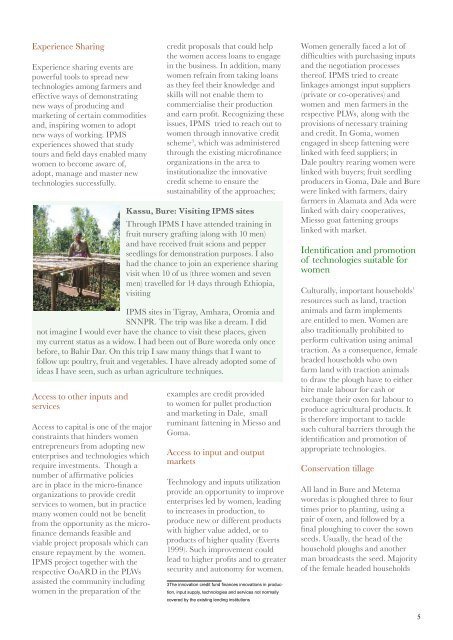Empowering women through value chain development - IPMS ...
Empowering women through value chain development - IPMS ...
Empowering women through value chain development - IPMS ...
Create successful ePaper yourself
Turn your PDF publications into a flip-book with our unique Google optimized e-Paper software.
Experience SharingExperience sharing events arepowerful tools to spread newtechnologies among farmers andeffective ways of demonstratingnew ways of producing andmarketing of certain commoditiesand, inspiring <strong>women</strong> to adoptnew ways of working. <strong>IPMS</strong>experiences showed that studytours and field days enabled many<strong>women</strong> to become aware of,adopt, manage and master newtechnologies successfully.Access to other inputs andservicesAccess to capital is one of the majorconstraints that hinders <strong>women</strong>entrepreneurs from adopting newenterprises and technologies whichrequire investments. Though anumber of affirmative policiesare in place in the micro-financeorganizations to provide creditservices to <strong>women</strong>, but in practicemany <strong>women</strong> could not be benefitfrom the opportunity as the microfinancedemands feasible andviable project proposals which canensure repayment by the <strong>women</strong>.<strong>IPMS</strong> project together with therespective OoARD in the PLWsassisted the community including<strong>women</strong> in the preparation of thecredit proposals that could helpthe <strong>women</strong> access loans to engagein the business. In addition, many<strong>women</strong> refrain from taking loansas they feel their knowledge andskills will not enable them tocommercialise their productionand earn profit. Recognizing theseissues, <strong>IPMS</strong> tried to reach out to<strong>women</strong> <strong>through</strong> innovative creditscheme 3 , which was administered<strong>through</strong> the existing microfinanceorganizations in the area toinstitutionalize the innovativecredit scheme to ensure thesustainability of the approaches;Kassu, Bure: Visiting <strong>IPMS</strong> sitesThrough <strong>IPMS</strong> I have attended training infruit nursery grafting (along with 10 men)and have received fruit scions and pepperseedlings for demonstration purposes. I alsohad the chance to join an experience sharingvisit when 10 of us (three <strong>women</strong> and sevenmen) travelled for 14 days <strong>through</strong> Ethiopia,visiting<strong>IPMS</strong> sites in Tigray, Amhara, Oromia andSNNPR. The trip was like a dream. I didnot imagine I would ever have the chance to visit these places, givenmy current status as a widow. I had been out of Bure woreda only oncebefore, to Bahir Dar. On this trip I saw many things that I want tofollow up: poultry, fruit and vegetables. I have already adopted some ofideas I have seen, such as urban agriculture techniques.examples are credit providedto <strong>women</strong> for pullet productionand marketing in Dale, smallruminant fattening in Miesso andGoma.Access to input and outputmarketsTechnology and inputs utilizationprovide an opportunity to improveenterprises led by <strong>women</strong>, leadingto increases in production, toproduce new or different productswith higher <strong>value</strong> added, or toproducts of higher quality (Everts1999). Such improvement couldlead to higher profits and to greatersecurity and autonomy for <strong>women</strong>.3The innovation credit fund finances innovations in production,input supply, technologies and services not normallycovered by the existing lending institutionsWomen generally faced a lot ofdifficulties with purchasing inputsand the negotiation processesthereof. <strong>IPMS</strong> tried to createlinkages amongst input suppliers(private or co-operatives) and<strong>women</strong> and men farmers in therespective PLWs, along with theprovisions of necessary trainingand credit. In Goma, <strong>women</strong>engaged in sheep fattening werelinked with feed suppliers; inDale poultry rearing <strong>women</strong> werelinked with buyers; fruit seedlingproducers in Goma, Dale and Burewere linked with farmers, dairyfarmers in Alamata and Ada werelinked with dairy cooperatives,Miesso goat fattening groupslinked with market.Identification and promotionof technologies suitable for<strong>women</strong>Culturally, important households’resources such as land, tractionanimals and farm implementsare entitled to men. Women arealso traditionally prohibited toperform cultivation using animaltraction. As a consequence, femaleheaded households who ownfarm land with traction animalsto draw the plough have to eitherhire male labour for cash orexchange their oxen for labour toproduce agricultural products. Itis therefore important to tacklesuch cultural barriers <strong>through</strong> theidentification and promotion ofappropriate technologies.Conservation tillageAll land in Bure and Metemaworedas is ploughed three to fourtimes prior to planting, using apair of oxen, and followed by afinal ploughing to cover the sownseeds. Usually, the head of thehousehold ploughs and anotherman broadcasts the seed. Majorityof the female headed households5
















